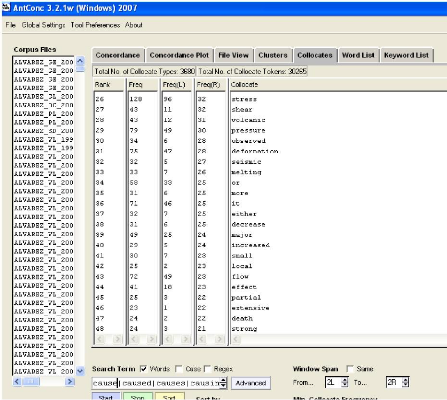c) To cause (langue de spécialité)
Nous avons, comme à chaque fois avant de commencer
l?analyse des concordances, observé les collocations significatives du
verbe « to cause » dans le CSTen, présentés cidessous,
dans la figure 14 :
Figure 14 : collocations significatives de « to
cause » dans le CSTen

Nous constatons à travers cette figure, que le verbe
« to cause " dans le domaine des sciences de la terre a une prosodie
sémantique neutre, puisque la plupart de ses collocations sont des mots
à connotation neutre, tels que : shear, volcanic, pressure,
deformation, seismic, melting, major, local, flow, effect, partial,
etc.
Mais nous avons voulu approfondir notre recherche, en
analysant les occurrences de « to cause " dans le CSTen. Ainsi, nous avons
examiné les différentes formes conjuguées (cause, causes,
caused, causing) de ce verbe anglais, qui a pour sens « make
something, (especially something bad) happen ". Pour ce fait, nous avons
obtenu 6053 concordances. Beaucoup moins qu?en langue générale,
mais assez pour constater que la prosodie sémantique de ce verbe devient
neutre, puisqu?il apparait très souvent avec des mots à
connotation neutre tels que : the cavity meltwater to overflow, a
friction-induced non-
continuous lowering of the temperature probe, a yellow
coloration of all surfaces, a slight spatial thinning of the shear zone, the
chemical composition of system to change, local dilation, melting and builds up
of a deformable water layer, pressure ridges and/or local breakouts, a further
opening of the fractures, vapour exsolution and crystallization, etc.
En voici des exemples:
Neutres :









The addition to the system of mass (magma) and meltwater derived
from inflowing ice may cause the cavity meltwater to
overflow supraglacially. Presently, it is difficult to judge definitely
what the source may cause the regular variations in
shear wave parameters with the period of 172 days Additionally, the strong
inclination might have caused a friction-induced
non-continuous lowering of the temperature probe
These observations indicate that an elevated dust layer
causes a yellow coloration of all surfaces
The lower thermal diffusivity causes a slight
spatial thinning of the shear zone By settling the crystals are being removed
from the magma, causing the chemical composition of system
to change.
At near maximum packing, shear causes
local dilation in narrow zones into which small grains selectively migrate
to form distinct bands of segregated grains
Heat transfer to the ice causes melting
and builds up of a deformable water layer; (3) further advance or inflation
of the magma causes pressure ridges and/or local
breakouts as pillows into the water-filled space.
We believe that small thermal stresses arising at the contact
with a colder fine-grained medium (matrix), during the accretion in different
parts of the clouds, caused a further opening of the
fractures.
Further ascent causes vapour exsolution and
crystallisation due to the rise in liquidus temperature
Il conviendrait de noter que nous avons aussi obtenu des
concordances où le verbe « to cause » entre en cooccurrence
avec des mots à connotation négative. Bien que ces
dernières restent beaucoup moins nombreuses que les cooccurrences
neutres détectées, il est intéressant de voir, à
travers les exemples cités ci-dessous, que les mots à
connotation
négative, qui entrent en cooccurrence avec le verbe
« to cause " dans le CSTen, impliquent toujours des humains (panic,
damage, problems,etc.), comme l?a constaté Hunston (2007) et l?ont
confirmé Kübler et Volanschi (à paraître).
Négatives:




This event reached an intensity of VIII on the MSK-European
Macroseimic scale in the epicentral area, caused panic
among people, severe damage in some buildings and killed six
persons
This occurred down the White River valley,
causing widespread damage to the south of the
island.
Water vapor, the most common gas released by volcanoes,
causes few problems.
The earthquake of 13 August 1887 (Io = VII °MCS)
caused heavy damage on churches and houses in
Jastrebarsko and the surrounding villages
Wei (2002) a constaté que dans les textes
académiques, la prosodie sémantique du verbe « to cause "
est plus négative que dans la langue générale. Mais dans
nos résultats, il semble que ce verbe a complètement
changé de prosodie sémantique, qui est passée de
très négative dans le BNC à carrément neutre dans
le corpus des sciences de la terre. Cela confirme une fois de plus
l?hypothèse de Partington (2004) selon laquelle une unité
lexicale dans une langue générale et une langue
spécialisé peut avoir une prosodie sémantique
différente et montre aussi que la prosodie sémantique peut aussi
changer d?un domaine spécialisé à un autre.
| 


